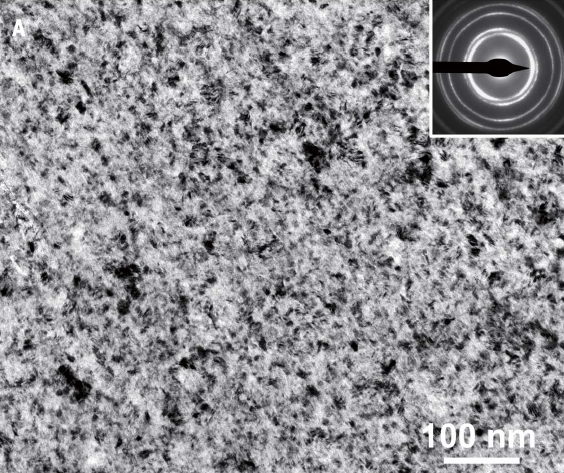
The strategy employs stable grain boundary networks to inhibit creep in metals
When a metal is stressed far below its yield strength at elevated temperatures, a process known as creep can occur. Creep, the time-dependent deformation of materials, is responsible for a great number of component failures at high temperatures. Scientists know that eliminating grain boundaries in materials is a useful way of resisting high-temperature creep in metals. However, a team of researchers has developed a different strategy for inhibiting creep by using stable grain boundary networks.
Their findings are published in the journal Science on November 10, 2022.

A bright-field TEM image showing extremely fine grains. (Image by IMR)
The team's strategy for a property enhancement differs fundamentally from that of the traditional strategies. "The behaviors of grain boundary networks may be fundamentally alerted when structural relaxation of grain boundaries is triggered through their interaction with partial dislocations below a critical grain size," said LI Xiuyan, a professor at the Institute of Metal Research of the Chinese Academy of Sciences. Using their new method, the team obtained an unprecedented creep resistance that outperformed that of conventional superalloys.
Creep is a costly problem. A great number of failures of materials and components at high temperatures are attributed to creep or to its combination with other degradation processes. These failures cost billions of dollars annually for the repair and replacement of parts in advanced devices. The demand for higher fuel efficiency and more reliable turbines, nuclear reactors, and devices in chemical industries continues to grow. With this growing demand, there is a growing need for improved high-temperature creep resistance in advanced alloys.
"Traditional development of alloys for high-temperature applications is primarily relying on the skillful addition of various alloying elements for strengthening the matrix or interfaces, or for forming reinforcing precipitates," said LI. "Such a strategy is facing a dilemma of limited property improvement with intensifying alloying and elevated cost."
Grain boundaries, defects in the crystal structure, are the interfaces where two crystals that have different orientations meet. Although conventional wisdom points to the elimination of grain boundaries to counter the problem of creep, the research team proposed introducing abundant grain boundaries to form stable grain boundary networks in metal to inhibit creep by suppressing atomic diffusion and hardening at high temperatures, simultaneously. The idea to take this approach was inspired by recent studies on grain boundary relaxation in metals.
The team found that grain boundaries can be used for strengthening alloys at elevated temperatures, contrary to the conventional wisdom that they always weaken the alloys at high temperatures. It is known that grain boundaries in metals and alloys are usually considered as a "weak component," as they may migrate or slide upon loading at elevated temperatures. "We found that grain boundaries in the nanograined single-phased alloy can be effectively stabilized through a structural relaxation, and the creep performance of the alloy are significantly enhanced at elevated temperatures," said LI. Distinct from the traditional alloying approach, the grain boundary relaxation offers a novel and sustainable strategy for advancing properties and performance of alloys for high-temperature applications.
Looking ahead to future research, the team sees room for stability enhancement by tailoring grain boundary networks in metals and alloys. "Therefore, the next step of this study is to extend this principle to other engineering alloy families for high-temperature applications, including nickel-based alloys and steels," said LI. The team plans to perform processing development to further promote the stability of grain boundary networks and to prepare large-size samples for measurements of more properties and performance at high temperatures. "Ultimately we hope to realize industrial applications of the high-performance engineering alloys with stable grain boundary networks," said LI.
This research is funded by the Ministry of Science and Technology of China, the National Natural Science Foundation of China, and the Chinese Academy of Sciences.

86-10-68597521 (day)
86-10-68597289 (night)

52 Sanlihe Rd., Xicheng District,
Beijing, China (100864)

